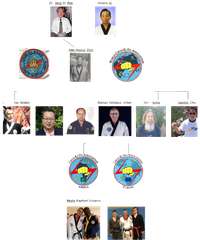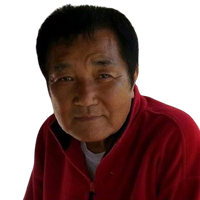HAPKIDO family tree grand masters Roman Urban MAN URBAN
Hapkido Description
Hapkido also spelled hap ki do or hapki-do
Die Entwicklung des Hapkido nahm in den 1910er Jahren ihren Anfang, als Korea unter japanische Herrschaft fiel. Der Koreaner Choi Yong-sul (1904–1986) wurde nach eigener Erinnerung um das Jahr 1912, im Alter von etwa acht Jahren, in die japanische Stadt Moji gebracht. In den folgenden Jahrzehnten, bis zum Ende der japanischen Herrschaft über Korea, lernte er laut eigener Aussage das japanische Daitō-ryū Aiki-jūjutsu unter dem Samurai Takeda Sōkaku (1859–1943).
Während es nicht belegt ist, dass Choi wirklich direkt unter Takeda trainiert hat, ist es unbestritten, dass er Jiu-Jitsu erlernte.
In diesem Zusammenhang erwähnenswert ist, dass unter Takeda auch Ueshiba Morihei (1883–1969), der Begründer des Aikidō, trainierte. Aus diesem Grund teilen Hapkido und Aikidō die gleichen Wurzeln.
Neben Choi hatten andere Koreaner in Japan Daitō-ryū Aiki-jūjutsu erlernt, unter anderen Dr. Chang In-Mok (geboren 1912). Nachdem 1945 die japanische Kolonialzeit vorüber war, kehrte er genau wie Choi in die koreanische Stadt Daegu zurück und lehrte dort einige Zeit lang Kampfkunst. Hauptsächlich war er Arzt der orientalischen Medizin und brachte im Gegensatz zu Choi nur wenige Schüler hervor. Unter den bemerkenswerten Studenten waren: Jang Seeung Ho, Song Joon Hwi, Choi, Han Young, Hu Il Wong (Lehrer von Peter und Joseph Kim) und Song Il Hun.
Han-Young Choi war Top-Student von Dr. In -Mok und entwickelte den Stil Chun Ki Do. Roman Nikolaus Urban war Top-Student von Han-Young Choi und verbreitet Chun Ki Do-Hapkido in Europa und in Afrika.
Choi Yong-sul bezeichnete die Kampfkunst, die er erlernt hatte, zunächst als Yawara, die altjapanische Bezeichnung für Jūjutsu. Aufgrund seiner langen Aufenthaltszeit in Japan sprach er nach seiner Rückkehr nach Korea zunächst zu etwa 70 % Japanisch und nur zu etwa 30 % Koreanisch. Während er an den Techniken nichts oder nur sehr wenig veränderte, änderte er den Namen seiner Kampfkunst mehrmals.
So nannte er sie Yu Sul (deutsch „weiche Technik“, dies ist die direkte Übersetzung von Jūjutsu ins Koreanische), Yu Kwon Sul („Weiche Fausttechnik“) und Hapki Yu Kwon Sul („Weiche Fausttechnik in Einheit mit Ki“).
Choi Yong-sul eröffnete am 12. Februar 1951 in Daegu zusammen mit seinem ersten Schüler Suh Bok-sup (revidierte Romanisierung: Seo Bok-seob) das Hapki Yu Kwon Sul Dojang.
Suh Bok-sup behauptet, dass er und Choi 1959 den Begriff Hapkido als Kurzform von Hapki Yu Kwon Sul geprägt haben und Choi selbst sagte, dass er seine Kunst als Hapkido bezeichnet habe.
Einer der ersten Schüler Chois wurde ab 1953 Ji Han-jae (geboren 1936), der für die Entwicklung, Geschichte und Verbreitung des Hapkido sehr wichtig werden sollte.
Hapkido verwendet sowohl Langstrecken- als auch Nahkampftechniken, bei denen Sprungtritte und Handschläge auf größere Entfernungen sowie Druckpunktschläge, Gelenksperren und Würfe auf kürzere Kampfentfernungen angewendet werden. Hapkido betont die Kreisbewegung, die Kraftumlenkung und die Kontrolle des Gegners.
Die Praktizierenden versuchen, durch Beinarbeit und Körperpositionierung Vorteile gegenüber ihren Gegnern zu erzielen, um die Hebelwirkung zu nutzen und den Einsatz von roher Kraft gegen rohe Kraft zu vermeiden.
Dojunim Han-Young Choi (15.05.2013):
Daniel Rogers from Louisiana asked me a great question about our lineage…posting
my response:
My lineage is influenced by four specific periods of my martial arts training:
1. My families martial arts based on stepping techniques (triangle step, cross step, skip step), turning, and jumping.
2. My early years of formal training at a Buddhist monastery in Kyongi do where I learned meditation, breathing, and application into the physical world.
3. Moodukwon training from Grandmaster Hwan Ki. I earned my first black belt from him in the 1940s.
4. Hosunsool (developed into modern Hapkido)- joint manipulation from Grandmaster Chang In Mok. Grandmaster Chang has the same training and lineage as Grandmaster Choi Yong Sul…both brought what we know as Hapkido to Korea from Japan, except the Grandmaster Choi commercialized it and Grandmaster Chang did not.
Grandmaster Chang focused on oriental medicine and acupuncture… I learned my acupuncture and pressure points from him.
5. Hapkido - our system — before I founded the World Chun Ki Association, I belonged to the Daehan Hapkido association and Kuk Sool Won Association.
One of my best friends was Suh In Hyuk's older brother, and he asked me to help spread Kuk Sool Won in Seoul.
In the old days, you spread your martial arts by fighting the owner of the neighbourhood schools…then taking them over and changing the names and techniques. One school at a time, I went neighbourhood by neighbourhood, fighting school owners and taking over schools in the name of Kuk Sool Won.
Then I moved to the U.S. and after getting fed up with the politics of Daehan and Kuk Sool Won, I quit and founded our association.
Currently, I consider Grandmaster Daniel Walker my senior student and heir to my association. I consider my son Master Sam Choi as the holder of everything I know, because he has had the most exposure to me, my arts, and my philosophy.

